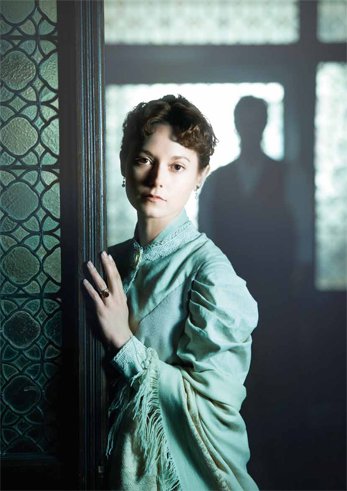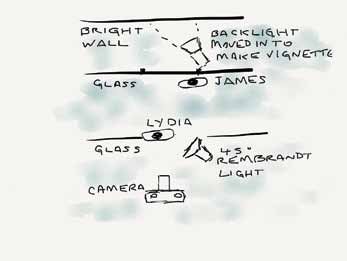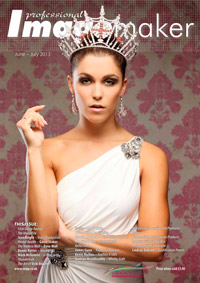articles/Lighting/lightingmaterclasssw-page1
Stuart Wood Lighting Masterclass - part 1 of 1
by Stuart Wood Published 01/06/2013

While the picture that was featured in the last issue was shot for myself, most of my work, I am very pleased to say in these challenging times, revolves around getting paid to trip the shutter. The image that I want to talk about in this issue was a commission from ITV to shoot the unit stills (action) and, as in this case, the 'set-ups' for the recent major TV drama The Making of a Lady.
These 'set up' images are normally shot away from the main set, so that you are not in the way of the filming and you can do something much more considered and have more overall control of the final image. These, along with the unit photography, will be the main holding shots in special articles featuring the programme or covers for magazines.
With these images it is vital to get good interaction with the camera and subject and to always leave room around the subject so that text can be added later and this hopefully encourages picture editors to consider them for the all important cover shot for the forthcoming week when the programme is finally transmitted.
One other important difference between grabbing quick action shots and the 'set ups' is your chance to control the lighting yourself, which is something that I relish.
Over the years I have also had to get good at spotting picture opportunities on location that are not too complicated or distracting, as I want the viewer to interact with the artist, but still capture a 'flavour' of the storyline.
I found this wonderful part of the old building where we were filming and it provided a perfect 'frame within a frame' and with my assistant as 'stand in' for the artists, I got to work realising the idea from my head to camera.
Backlighting can be extremely dramatic and with all the old glass in the background providing a perfect opportunity for this, it also allowed me to light the star of the drama, Lydia Wilson, with the beautiful Rembrandtstyle lighting to one side, knowing that the dark side of her face would not disappear but would be clearly defined against the bright background.
Considering that we needed to evoke a bygone era of the old Victorian paintings, this proved very appropriate.
On a more practical level and as this part of the building was pretty dark and being regularly walked through by cast and crew alike, I decided to avoid any unwanted leads to my two lights for everyone's safety and selected two Elinchrom Ranger units, which run off powerful batteries.
I placed one behind the glass to the rear facing a very convenient bright wall and moved it closer to the wall to achieve the natural vignetting around the image. This light had the standard metal reflector only attached to it.
The main light on Lydia had a small square soft-box attached to give the defined lighting that I wanted on her and this was placed at 45 degrees to achieve the desired Rembrandt.
Exposure was taken from the main light and then the backlight was adjusted to give a reflective reading of around a stop-and-a-half more exposure than the main light, with the small 'hot' area around the heads of the actors around two stops. This was vital as we always look at the brightest part of the image and so here we are automatically drawn to the two actors in the image.
I wanted a slightly telephoto perspective so I selected my 70-200mm lens and shot it at around 135mm as I wanted the 'threat' behind Lydia to be dragged forward and literally over her shoulder.

The 'threat' was played by the big actor James Darcy, who was not best pleasedthat he would only end up being a silhouette!
The main consideration with TV photography is that you are never the priority as the filming always takes precedence and so you have to be good at choosing your moments, calling in favours, not making any enemies and most of all getting the very best out the short opportunities that you will be given.
We shot this image very late in the day when the filming has usually slipped behind schedule but because the director, Richard, was very pro publicity and also friendly and approachable (two traits not necessarily normally found within the film industry!) I literally pleaded with him to give me both artists for ONE minute and we would get a wonderful main image for his show.
Despite being behind he held up his filming and very kindly let me have them both for 60 seconds only.
Thank goodness that he did because all the preparation that we had done meant that we could quickly put the actors in place and they responded wonderfully with Lydia giving me the vulnerable look that I asked of her, (actors love for you to give them direction) and in that minute I managed to create one of my absolutely favourite images of 2012 and it went on to be used as the DVD and audiobook cover too.
I think that it's also called living on the edge!
You are currently on page 1 Contact Stuart Wood
1st Published 01/06/2013
last update 09/12/2022 14:55:55
More Lighting Articles
There are 0 days to get ready for The Society of Photographers Convention and Trade Show at The Novotel London West, Hammersmith ...
which starts on Wednesday 15th January 2025





